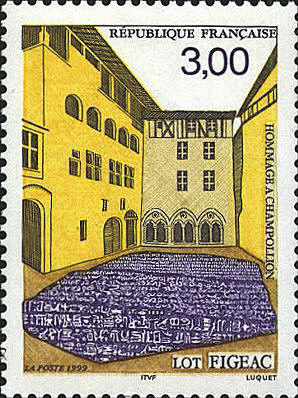|
Rosetta Stone
In 1799 the Rosetta Stone,
a 3½ foot long piece of granite, was discovered in Rashid (Rosetta),
Egypt. It was engraved in three languages and scripts, Egyptian
hieroglyphics, demotic and ancient Greek. It was believed that the
three messages were actually one in three different scripts. It was
deciphered by Thomas Young, and translated by Jean François
Champollion in 1822, using the Greek inscription as the basis. The
stone was dated March 196 b.c. on the basis of the content of the
inscription.

The representation of the Rosetta Stone on the stamp Is
upside down and out of proportion. Also the hieroglyphs drawn by the
artist are not those on the actual stone.

This stamp was issued in 1990 commemorating the 200th anniversary of
the birth of Jean-François Champollion (1790-1832). The Rosetta Stone
was discovered by Lt. Pierre Bouchard in 1799. It was deciphered by
Thomas Young, and translated by Champollion in 1821-1822.



|
